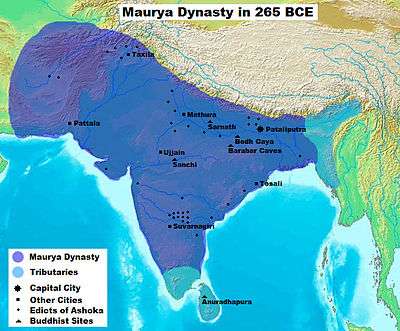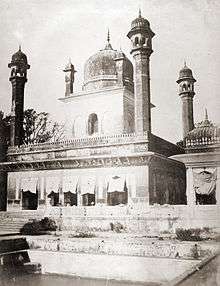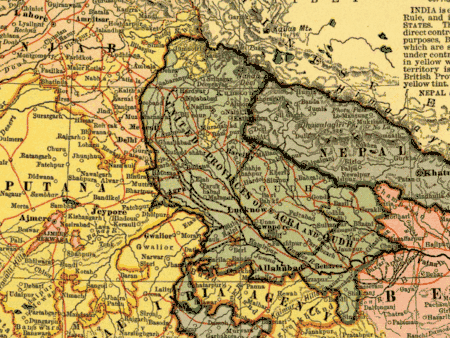History of Dehradun

Dehradun is the capital of The Indian state of Uttarakhand, and has a rich and eventful history, it also finds mention in scriptures as well.
During the British Raj, the town was known as Dehra, while the district was known as Dehra Dun.[1]
History
Ancient history

In Skanda purana, Dun is mentioned as a part of the region called Kedar Khand, the abode of Shiva. In ancient India during the Mahabharata epic era, Dronacharya the great teacher of Kauravas and Pandavas lived here hence the name, "Drona-nagri".[2]
A rock edict of Ashoka, the legendary Mauryan King, who ruled between 273 BC to 232 BC, was discovered at Kalsi, 56 km. from Dehradun by John Forest, in 1860.[3][4]
Present Dehradun

According to the history of Dehradun it has been part of Garhwal Kingdom except for the brief interlude of rohillas. The present town of Dehradun was named after 'Guru Ram Rai', the elder son of seventh Sikh Guru, Guru Har Rai, who was part of the Udasi sect of Sikh Asceticism,[5] who came here in 1675, and first settled in village 'Dhamawala', which even today hosts the annual 'Jhanda Fair' on the fifth day after Holi in his memory.[6] Thus the name refers to his Dera or settlement in the valley, around which the present town gradually developed,[7] and marking this settlement is a Gurudwara called 'Guru Ram Rai Darbar', built in 1699 with the help of Raja of Garhwal, Fateh Shah, who was succeeded by his grandson in the same year, Pratap Shah,[1] and modelled on the tomb of Mughal Emperor Jehangir.[8]
Dehradun was a part of Tehri Garhwal Kingdom, then after it was a part of Gorkha Kingdom for 12 years. Gurkhas lost Dehradun to England when India was colonized by England. Historically, Dehradun has remained part of the Garhwal Kingdom also known as 'Kedarkhand', which was founded by Ajai Pal, around 1400, by capturing all the minor principalities of the Garhwal region, under his own sway, and thereafter, he and his descendants ruled over Garhwal and the adjacent state of Tehri-Garhwal, in an uninterrupted line till 1803, when Gurkhas invaded Kumaon and Garhwal.[9]
In between, until Najib-ul-Daula, the governor of Saharanpur, who later founded city of Najibabad, invaded the city with his army of Rohillas in 1757, and ruled here, leading to its widespread development, though after his death in 1770, it was successively annexed by surrounding tribes of Rajputs, Gujjars, Sikhs and Gurkhas who ruled the region in quick succession, and lead to its steady downfall.
Finally, in 1803, it was annexed by the Gurkhas, who made the king of Garhwal, Pradyuman Shah, flee to Saharanpur, leaving the region to be ruled by an iron fist by the Gurkha general 'BAL BHADRA KUNWAR'. Later, King Pradyumna Shah and his sons Kuwar Parakrama Shah and Kuwar Pritam Shah, and a 12,000 strong army fought with the Gorkhas at Khurhbure, where the king was killed.

In the same year, the British had already taken over Saharanpur, which led to continuous skirmishes between the two armies, leading to the Gurkha War (1814–1816), also known as the Anglo-Nepalese War, when eventually the Gurkhas were ousted after the siege of the fort of Nalapani.
The Sugauli Treaty, signed on 2 December 1815 and ratified by 4 March 1816, between the British East India Company and The Kingdom of Nepal, ending the second British invasion of the Himalayan kingdom during the Anglo-Nepalese War (1814–1816). The signatory for Nepal was Raj Guru Gajaraj Mishra aided by Chandra Sekher Upadhyaya and Lieutenant-Colonel Paris Bradshaw signed for the Company.
The treaty led to the annexation of the Dehradun and east Garhwal Kingdom into the British Empire, and they became part of the Garhwal District, in the Kumaon Division of the United Provinces, and had an area of 5629 sq. mi, and that is when it slowly started regaining its lost glory.[10][11][12] Meanwhile, the west Garhwal was reinstituted to the Garhwal Kingdom, and Sudarshan Shah, son of the slain king, was made the king of Tehri Garhwal, who made Tehri his capital.
'Dehra Dun' municipality was established in 1867, and in 1900 railways made its way to Dehradun via Haridwar, which was earlier connected in 1886.[13]
In 1901, Dehradun had a population of 24,039,[8] and was a district of British India, in the Meerut division of the United Provinces,[10] while the neighbouring town of Rajpur, which lay en route to the hill-station of Mussourie, and from where pure-drinking water was supplied to the city through pipes, had a population of 2,900.[14]
During the Second World War the Dehra Dun Central Internment Camp was a major prison camp for detained German, Austrian and Italians who were living in or visiting British colonies in Asia at the start of the war.[15] Its most famous inmate was perhaps Heinrich Harrer, who after several attempts finally escaped in 1944 with Peter Aufschnaiter and slipped over the mountains into neutral Tibet. He recounted his time at the camp in Seven years in Tibet (Rupert Hart-Davis, 1953) and Beyond seven years in Tibet: my life before, during and after. (Labyrinth Press, 2007). Several German Buddhist monks, including Nyanatiloka, also stayed here. The camp was divided into different sections, one for Germans loyal to the Nazi government, one for German communists and others who rejected the Nazi government, one for Italians, and one section for Italian Catholic clergy.[16]
See also
References
- 1 2

- ↑ A Brief History and profile of Dehradun Archived 19 May 2007 at the Wayback Machine. Government of Uttarakhand website.
- ↑ . Rock edict
- ↑ Epigraphy – Rocks The Imperial Gazetteer of India, 1909, v. 2, p. 41.
- ↑
- ↑ Guru Ram Rai Darbar Archived 4 June 2008 at the Wayback Machine. Official website of Dehradun.
- ↑ Other cities with similar names are Dera Ismail Khan, Dera Bugti and Dera Ghazi Khan in Pakistan.
- 1 2 Dehra Town The Imperial Gazetteer of India, 1909, v. 11, p. 221-223.
- ↑

- 1 2

- ↑ History, Dehra Dun District The Imperial Gazetteer of India, 1909, v. 11, p. 211-214.
- ↑ History Archived 23 January 2008 at the Wayback Machine. Official website of Dehradun district.
- ↑

- ↑ Rajpur Town (2) The Imperial Gazetteer of India, 1909, v. 21, p. 82.
- ↑ Escape from Internment – collection of articles by and about former prisoners of Dehra Dun. Bhikkhu Nyanatusita and Hellmuth Hecker, The Life of Nyanatiloka: The Biography of a Western Buddhist Pioneer Kandy, 2009.
- ↑ Bhikkhu Nyanatusita and Hellmuth Hecker, The Life of Nyanatiloka: The Biography of a Western Buddhist Pioneer Kandy, 2009.
External links
| Wikimedia Commons has media related to History of Dehradun. |